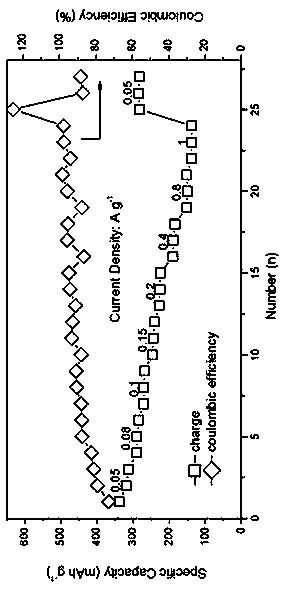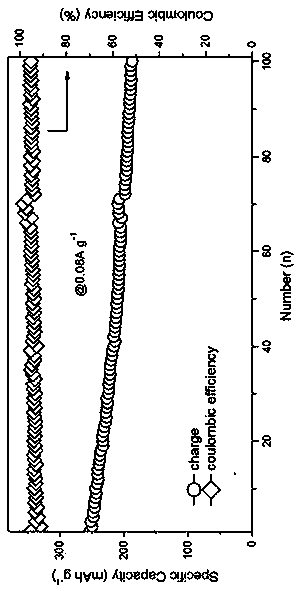Preparation method of two-dimensional porous hexagonal metal oxide nanosheet composite material and application of the composite material in potassium ion battery
A composite material, hexagonal technology, applied in the field of preparation of two-dimensional porous hexagonal metal oxide nanosheet composite materials, can solve the problems of low conductivity, capacity decay, poor rate performance and cycle performance, etc.
- Summary
- Abstract
- Description
- Claims
- Application Information
AI Technical Summary
Problems solved by technology
Method used
Image
Examples
Embodiment 1
[0034] Preparation of MnO@a-TiO 2 -Vo NHSs composite materials
[0035] Step S1: Dissolve 0.1-1g SA in 70mL 0.01-0.1mol L under stirring condition -1 Li 2 CO 3 and 0.01-0.1mol L -1 KMnO 4 Then transfer the mixed solution to a 100mL stainless steel autoclave lined with polytetrafluoroethylene for hydrothermal reaction at 120-150°C for 10-20h, and then repeatedly wash the precipitate with deionized water and ethanol by centrifugation , dried at 60 °C for 8 h to obtain MnCO 3 NHSs precursors;
[0036] Step S2: 0.1-0.8g of MnCO obtained in step S1 3 The NHSs precursor was added to a mixed solution containing 100-1000mL absolute ethanol and 0.6-3mL ammonia solution with a mass percentage of 28%, ultrasonicated for 30min and stirred at 30-50°C for 30min to obtain a uniform dispersion, and then added dropwise 1-5mL titanium isopropoxide and react at 30-50°C for 30-50h, then repeatedly wash the precipitate with ethanol by centrifugation, and dry at 80°C for 12h to obtain MnCO ...
Embodiment 2
[0042] Preparation of NiO@a-TiO 2 -Vo NHSs composite materials
[0043] Step S1: under stirring condition, mix 1-3g surfactant CTAB and 1-5mmol nickel source C 4 h 6 NiO 4 4H 2 O was added to the mixed solution of 60mL ethanol and 11mL water in turn, stirred ultrasonically for 1h to form a uniform solution, and then transferred the uniform solution to a 100mL stainless steel autoclave lined with polytetrafluoroethylene and reacted hydrothermally at 150-200°C for 20- 30h, then repeatedly washed the precipitate with deionized water by centrifugation, and dried at 80°C for 12h to obtain light green β-Ni(OH) 2 NHSs precursors;
[0044] Step S2: 0.1-0.8g of β-Ni(OH) obtained in Step S1 2The NHSs precursor was added to a mixed solution containing 100-1000mL absolute ethanol and 0.6-3mL ammonia solution with a mass percentage of 28%, ultrasonicated for 30min and stirred at 30-50°C for 30min to obtain a uniform dispersion, and then added dropwise 1-5mL titanium isopropoxide and...
Embodiment 3
[0047] Preparation of Co 3 o 4 @a-TiO 2 -Vo NHSs composite materials
[0048] Step S1: Dissolve 3-4mmol cobalt nitrate hexahydrate in a mixed solution of 30mL water and 30mL triethylene glycol under stirring conditions, then add 0.1-1g urea and obtain a uniform solution under mild stirring conditions, transfer the uniform solution In a 100mL stainless steel autoclave lined with polytetrafluoroethylene, hydrothermally react at 100-150°C for 20-30h, then repeatedly wash the precipitate with deionized water and ethanol by centrifugation, and dry at 60°C for 24h to obtain Co(CO 3 ) 0.5 (OH) x 0.11H 2 O NHSs precursors;
[0049] Step S2: 0.1-0.8g of Co(CO) obtained in Step S1 3 ) 0.5 (OH) x 0.11H 2 O NHSs precursor was added to a mixed solution containing 100-1000mL absolute ethanol and 0.6-3mL ammonia solution with a mass percentage of 28%, ultrasonicated for 30min and stirred at 30-50°C for 30min to obtain a uniform dispersion, and then dropwise Add 1-5mL titanium isop...
PUM
 Login to View More
Login to View More Abstract
Description
Claims
Application Information
 Login to View More
Login to View More - R&D
- Intellectual Property
- Life Sciences
- Materials
- Tech Scout
- Unparalleled Data Quality
- Higher Quality Content
- 60% Fewer Hallucinations
Browse by: Latest US Patents, China's latest patents, Technical Efficacy Thesaurus, Application Domain, Technology Topic, Popular Technical Reports.
© 2025 PatSnap. All rights reserved.Legal|Privacy policy|Modern Slavery Act Transparency Statement|Sitemap|About US| Contact US: help@patsnap.com



